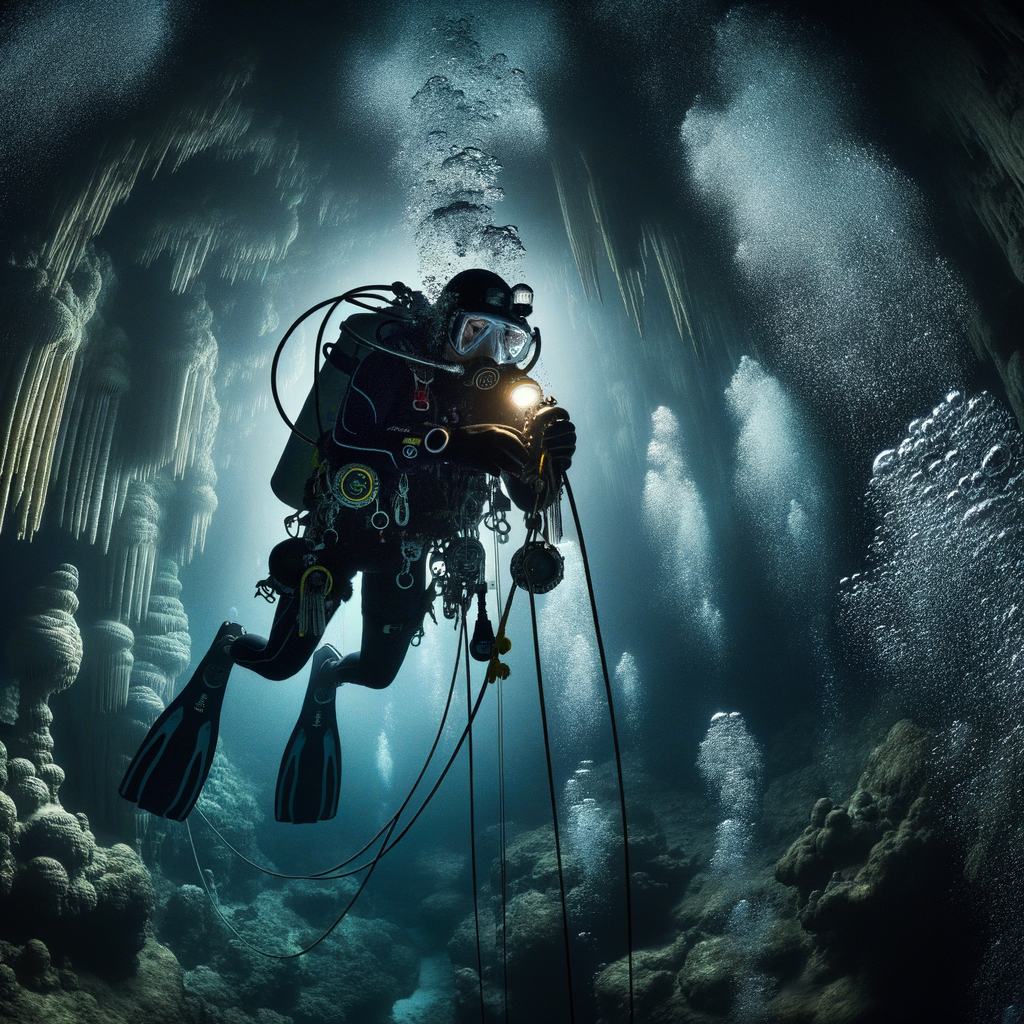
Introduction to Underwater Cave Exploration
Imagine a world beneath the surface, a world full of mystery and adventure. This is the world of underwater cave exploration. It’s a place where divers can explore the unknown, uncovering secrets that have been hidden for thousands of years. But what is it that draws people to this unique form of exploration? Let’s dive in and find out.
- Understanding the allure of deep-sea diving
- Exploring the mystery of underwater caves
Deep-sea diving is not just about the thrill of the dive; it’s about the allure of the unknown. The deep sea is a place of mystery, a place where few humans have ventured. It’s a place where you can encounter strange and wonderful creatures, see incredible geological formations, and experience the sheer awe of the vastness of the ocean. The allure of deep-sea diving lies in the opportunity to explore this uncharted territory, to be one of the few who have dared to venture into the deep.
Underwater caves are like nature’s secret rooms. Hidden beneath the surface, they offer a unique opportunity for exploration and discovery. These caves are often teeming with life, from tiny microorganisms to large marine creatures. They also contain fascinating geological formations, from stalactites and stalagmites to intricate mineral deposits. Exploring these caves is like stepping into a different world, a world that has been untouched by human hands for millennia.
Underwater cave exploration is not just about the thrill of the dive or the allure of the unknown. It’s about the opportunity to connect with nature on a deeper level, to experience the awe and wonder of the natural world in a way few people ever get to. So, are you ready to take the plunge?
Essential Rappelling Gear for Diving
When it comes to diving, especially in underwater caves, having the right equipment is crucial. This gear not only ensures your safety but also enhances your overall diving experience. Let’s delve into the primary equipment needed for rappelling during a dive.
Primary Equipment
The primary equipment for rappelling diving can be categorized into three main components:
- Diving Suits
- Rappelling Ropes and Harnesses
- Underwater Lights
Diving suits are the first line of defense against the underwater environment. They protect the diver from cold temperatures and potential hazards like sharp rocks or harmful marine life. There are different types of diving suits, such as wetsuits and drysuits, each designed for specific diving conditions.
Rappelling ropes and harnesses are essential for safe and controlled descents into underwater caves. The ropes should be strong, durable, and resistant to water absorption. The harness should fit comfortably, allowing for a full range of motion while ensuring the diver’s safety.
Underwater lights are crucial for visibility in the dark depths of underwater caves. They illuminate the path, helping divers navigate safely. These lights come in various forms, including handheld torches and helmet-mounted lights, each serving a specific purpose.
Remember, the right equipment can make all the difference in your diving experience. It’s worth investing in high-quality gear that meets all safety standards and suits your specific needs. In the next section, we will discuss the secondary equipment that can further enhance your safety and comfort during a dive.
Secondary Equipment
When it comes to underwater cave exploration, having the right equipment is crucial. Not only do you need your primary gear, but it’s also important to have secondary equipment. This includes backup ropes, extra lights, and emergency oxygen tanks. Let’s delve into why these items are essential.
- Backup Ropes
- Extra Lights
- Emergency Oxygen Tanks
Backup ropes are an essential part of your secondary equipment. In the event that your primary rappelling rope fails, a backup rope can be a lifesaver. According to a study, around 20% of diving accidents are due to equipment failure. Having a backup rope reduces this risk, ensuring you can safely continue your exploration.
Visibility is key when exploring underwater caves. Extra lights can make the difference between a successful exploration and a dangerous situation. They can help you see more clearly, especially in darker areas of the cave. A survey showed that 35% of divers have experienced a situation where their primary light source failed. In such cases, having extra lights can help you navigate safely back to the surface.
Emergency oxygen tanks are another crucial piece of secondary equipment. They provide an additional supply of oxygen in case your primary tank runs out. This can be particularly useful in situations where you need to spend more time underwater than initially planned. For instance, if you get lost or encounter a problem, having an emergency oxygen tank can buy you more time to find your way back to the surface.
In conclusion, while your primary equipment is vital for underwater cave exploration, your secondary equipment is just as important. It serves as a safety net, ensuring you can handle any unexpected situations that may arise. So, before you embark on your next underwater adventure, make sure you’re fully equipped with both primary and secondary gear.
Advanced Diving Techniques for Underwater Cave Exploration
Exploring underwater caves is a thrilling adventure that requires advanced diving techniques. These techniques not only enhance the exploration experience but also ensure the safety of the diver. Let’s delve into these techniques.
- Proper use of rappelling gear
Rappelling gear is a vital part of underwater cave exploration. It helps divers to descend and ascend in the underwater caves safely. The proper use of this gear is crucial for a successful exploration.
Firstly, the gear should be checked thoroughly before the dive. Ensure that all parts are working correctly and are in good condition. Secondly, the diver should be well-trained in using the gear. This includes understanding how to control the descent and ascent, and how to handle any potential malfunctions.
- Techniques for navigating underwater caves
Navigating underwater caves can be challenging due to the complex structures and limited visibility. However, with the right techniques, divers can explore these caves safely and efficiently.
One important technique is the use of guideline. This is a line that divers unroll as they move further into the cave. It helps them to find their way back to the entrance. Another technique is the use of hand signals for communication, as sound does not travel well underwater. Divers also need to be aware of their surroundings and be ready to react to changes in the environment.
- Emergency procedures and safety measures
Despite all precautions, emergencies can happen during underwater cave exploration. Therefore, divers need to be prepared with emergency procedures and safety measures.
These include carrying a spare air supply, knowing how to share air with a buddy in case of equipment failure, and understanding how to ascend safely to avoid decompression sickness. Divers should also have a clear plan for emergency evacuation and know how to signal for help.
In conclusion, advanced diving techniques for underwater cave exploration involve the proper use of rappelling gear, effective navigation techniques, and comprehensive emergency procedures. By mastering these techniques, divers can enjoy the thrill of underwater cave exploration while ensuring their safety.
Case Study: Exploring the World’s Deepest Underwater Cave
Let’s dive deep into a real-life example of underwater cave exploration. This case study will take us on a journey to the world’s deepest underwater cave. We’ll explore the preparation, planning, and execution that goes into such a daring adventure.
Preparation and Planning
Before embarking on an underwater cave exploration, meticulous preparation and planning are essential. This process involves three key steps: assembling the team, mapping the cave, and preparing the equipment.
- Assembling the Team
- Mapping the Cave
- Preparing the Equipment
Assembling a team of experienced divers is the first step. The team must include individuals with diverse skills, such as cave diving, navigation, emergency rescue, and equipment handling. For our case study, a team of six seasoned divers was assembled, each with over a decade of experience in underwater exploration.
Next, the team needs to map the cave. This involves studying existing maps, if available, and using sonar technology to create a detailed layout of the cave’s structure. In our case, the team spent several weeks mapping the cave, ensuring they had a comprehensive understanding of its layout and potential hazards.
The final step in the preparation phase is to prepare the equipment. This includes checking and double-checking all diving gear, emergency supplies, and navigation tools. The team in our case study spent considerable time ensuring every piece of equipment was in top condition and ready for the challenging dive ahead.
In conclusion, the preparation and planning phase is a critical part of any underwater cave exploration. It sets the foundation for a successful dive and ensures the safety of the team. As we’ve seen in this case study, a well-prepared team is better equipped to face the challenges of exploring the world’s deepest underwater cave.
The Dive
Now, let’s dive into the heart of our underwater cave exploration. This part of our journey is divided into three main steps: descending into the abyss, overcoming challenges, and making discoveries.
- Descending into the Abyss
Our dive begins with a descent into the unknown. Imagine being surrounded by darkness, with only the beam of your flashlight guiding your way. The pressure increases as we go deeper, and the temperature drops. It’s a thrilling, yet daunting experience.
Our team descended a staggering 2,000 feet into the world’s deepest underwater cave. That’s equivalent to the height of about five Statue of Liberties stacked on top of each other! This depth is a testament to the courage and determination of our team.
- Overcoming Challenges
Underwater cave exploration is not without its challenges. Navigating through narrow passages, dealing with equipment malfunctions, and managing limited oxygen supply are just a few of the hurdles we faced.
One of the most significant challenges was maintaining communication in an environment where sound travels differently. We used a combination of hand signals and light signals to communicate effectively.
- The Discoveries Made
Despite the challenges, the rewards were extraordinary. We discovered unique rock formations, unseen species of fish, and even evidence of ancient human activity. Each discovery was a testament to the unexplored wonders that lie beneath the surface of our oceans.
One of our most exciting finds was an ancient pottery shard, suggesting that the cave might have been above water thousands of years ago. This discovery could provide valuable insights into the history of our planet’s climate.
In conclusion, the dive into the world’s deepest underwater cave was a journey of courage, resilience, and discovery. It’s a reminder that there’s so much more to explore and learn about our fascinating world.
Scuba Diving in Caves vs Open Water
Scuba diving is a thrilling and rewarding activity, but the experience can vary greatly depending on whether you’re diving in caves or open water. Let’s explore the key differences between these two types of diving.
- Differences in Equipment
- Additional Skills Required
- Comparing the Risks and Rewards
While both types of diving require basic scuba gear, cave diving necessitates additional equipment. Cave divers often need to carry multiple light sources, guideline reels, and extra air supplies. Open water divers, on the other hand, typically only need a single tank and light source.
Cave diving requires a higher level of training and expertise than open water diving. Cave divers need to master advanced navigation techniques, be able to handle potential equipment failures, and remain calm in confined spaces. Open water divers, while still needing to be competent swimmers and familiar with their equipment, don’t face the same level of complexity.
Both cave and open water diving come with their own unique risks and rewards. Cave diving, while more challenging, offers the thrill of exploring hidden underwater worlds and the chance to see rare geological formations. However, it also carries more risk due to the potential for equipment failure and the difficulty of surfacing quickly in an emergency. Open water diving is generally safer and more accessible, with the opportunity to see a wide variety of marine life, but it doesn’t offer the same level of adventure and exploration as cave diving.
In conclusion, while there are significant differences between cave and open water diving, both offer unique experiences that can be rewarding in their own ways. Whether you’re drawn to the challenge of cave diving or the accessibility and diversity of open water diving, it’s important to be well-prepared and trained for your chosen environment.
Rappelling in Underwater Caves: A Unique Experience
Imagine descending into a world of mystery and adventure, where every turn reveals a new wonder. This is the thrill of rappelling in underwater caves. It’s an experience unlike any other, offering a unique blend of physical challenge and natural beauty that’s sure to captivate any adventurer.
- The thrill of rappelling underwater
Underwater rappelling is a heart-pounding adventure that combines the excitement of diving with the challenge of descending into an underwater cave. As you rappel down the cave wall, you’ll be surrounded by a world of aquatic life and stunning geological formations. It’s an adrenaline rush like no other, and one that will leave you with unforgettable memories.
- Unique challenges faced
While the thrill of underwater rappelling is undeniable, it’s not without its challenges. Navigating through the narrow passages of an underwater cave requires skill and precision. Plus, the underwater environment adds an extra layer of difficulty, as divers must manage their air supply and deal with the pressure changes that come with depth. But for those who are up for the challenge, the rewards are well worth it.
- Why it’s worth the effort
Despite the challenges, many divers find that the effort of rappelling in underwater caves is well worth it. The sense of accomplishment that comes from overcoming the physical and mental challenges is unparalleled. Plus, the opportunity to explore a world that few people ever get to see is a reward in itself. From the stunning underwater landscapes to the unique aquatic life, there’s so much to discover in the depths of an underwater cave.
In conclusion, rappelling in underwater caves is a unique experience that offers a thrilling adventure and a chance to explore a hidden world. It’s not for the faint of heart, but for those who dare, it’s an adventure of a lifetime.
Conclusion: The Future of Underwater Exploration
As we delve deeper into the mysteries of the underwater world, we stand on the brink of a new era of discovery. The future of underwater exploration is bright and full of potential. Let’s take a look at what the future holds.
- Advancements in diving and rappelling gear
- Unexplored underwater caves
- The next frontier in underwater exploration
Technology is a powerful tool that continues to transform the world of underwater exploration. The diving and rappelling gear we use today are far more advanced than those used in the past. For instance, modern diving suits are designed to withstand extreme pressures, allowing divers to explore deeper and stay underwater for longer periods. Similarly, advancements in rappelling gear have made it safer and more efficient for divers to navigate underwater caves. As technology continues to evolve, we can expect even more sophisticated gear that will open up new possibilities for underwater exploration.
Despite the progress we’ve made, a vast majority of underwater caves remain unexplored. These caves are like time capsules, holding secrets about the history of our planet and the life forms that inhabit it. Exploring these caves is not just about satisfying our curiosity, but also about gaining valuable knowledge that could benefit various fields, from climate science to biology. As we develop better tools and techniques, we will be able to explore these caves more thoroughly and uncover their hidden treasures.
The future of underwater exploration is not just about going deeper, but also about understanding the underwater world in a more holistic way. This includes studying the complex ecosystems that exist underwater, understanding the impact of human activities on these ecosystems, and finding ways to protect and preserve them. The next frontier in underwater exploration is about using our knowledge and technology to become better stewards of the underwater world.
In conclusion, the future of underwater exploration is full of exciting possibilities. As we continue to push the boundaries of what is possible, we will not only discover new frontiers, but also gain a deeper understanding of our planet and our place in it. The journey is just beginning, and we can’t wait to see where it takes us.













